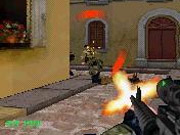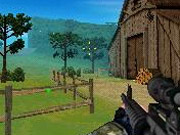First-person shooters don't exactly have an auspicious history on the N-Gage. Until the release of Gameloft's Tom Clancy's Ghost Recon: Jungle Storm, N-Gagers had only two to choose from--the massively defective Red Faction and the considerably more competent but still somewhat inconsistent Ashen. Gameloft apparently incorporated a number of lessons learned from these precursors into its creation of Jungle Storm, in addition to having tuned the game's engine to milk a better performance from the N-Gage's Series 60 hardware. The results of this conscientious R&D effort affirm Nokia's main N-Gage platitude: Developing native games for the N-Gage platform is a learning process, and companies like Gameloft are beginning to get the knack for doing it. There are a few bumps in the overall experience, but even so, Ghost Recon: Jungle Storm is the most broadly featured, enjoyable FPS for the N-Gage yet.

Ghost Recon: Jungle Storm is set in the steamy jungles and colonial townships of Colombia circa 2010--an era of fresh internal stresses for the already unstable Latin American nation. A new rebel group, the MFLC, has spread like a cancer into Colombia's body politic. Encouraged by their environment's lack of effective central authority, these neo-Marxists have really gotten up to the dickens. They've run down the whole insurgency laundry list by peddling drugs, taking hostages, and threatening to tear Colombia to tatters, thus destabilizing the region. Naturally, "The Boys in Washington" frown upon this activity, so they've sent in your team of ghosts to both operate behind rebel lines and disrupt their criminal activities.
The single-player game covers eight missions that span your four ghosts' efforts to tidy up the MFLC mess with a little elbow grease and lots of cordite. Your campaign kicks off with a simple hostage-rescue mission, but before long, you'll be taking the fight to the rebels by sabotaging their rail transportation, laying waste to their compounds, and dropping as many of their elite terrorists as possible. Before each mission, you'll outfit your principal ghost, Coalwater, with primary and secondary weapons. These can include submachine guns, pistols, grenade launchers, rocket launchers, sniper rifles, and even binoculars. In addition, completing each mission unlocks a new weapon, such as the coveted AK-47. Each of these boomsticks has different accuracy, damage, and range attributes, as well as an entirely unique feel in combat. As a result, some guns can zoom in on enemies very effectively, while others are worthless while running; still others have no sighting options at all. The only dull spot here seems to be your thrown grenades, which don't have the realistic feel or action of the rest of the game's weapons.
Inexplicably, you can only choose Coalwater's weapons set; the other ghosts' arsenals are selected by the CPU, even though you can play as any of the four soldiers with the press of a button. While Gameloft preserved a bit of the Ghost Recon franchise's team-tactics feel, the publisher-developer opted to shift the gameplay toward a much more straightforward FPS model. For instance, the only two, actual team commands you can give either order two ghosts to a particular location or call for all your ghosts to shoot at a particular target. Otherwise, you'll have to leave control of your three team members to the CPU, which does a generally competent job of wasting any terrorist that starts shooting at you from your flanks. Still, Gameloft did well to include this vestigial team-play aspect in Jungle Storm, because it heightens the game's jungle-combat atmosphere.
Overall, Jungle Storm's core FPS gameplay is a triumph. Everything in the game--from the level designs, to firing weapons, to your heads-up display--has been conscientiously designed to be as intuitive and N-Gage-friendly as possible. The levels aren't too big, meaning you can navigate and complete them in bite-sized chunks of time. You are also provided with a detailed map that indicates your position, relative to your objectives, as well as the entire area's layout. During combat, your targeting reticle expands or contracts depending on how accurate your shot is, and Gameloft's provided two levels of auto-aiming to make the job of targeting with the N-Gage keypad a much easier affair. Gameloft's also dispensed with the need to search out tiny power-ups and extra clips by simply giving you three backup team members and plenty of ammo. Even if several of your ghosts get faded during a mission, you'll still have a chance to finish your objectives. Finally, Jungle Storm's heads-up display gives you all the visual feedback you need without being gratuitous and without complicating gameplay matters. For instance, red bars indicate the direction from which you're taking enemy fire, which makes the game's narrow field of vision (constrained by the N-Gage's vertically oriented screen) less of a hassle. Furthermore, all of your objectives are indicated--one after the other--by bright green numbers in your HUD. As you run toward the marker, a distance indicator will count down, letting you know exactly how far you have left to go.
These touches may seem minor when taken individually, but taken together, they increase Jungle Storm's playability ratio tremendously, and they help to smooth over some of the game's other minor problems. The most serious of these problems deals with run speed. The game runs at about 20 frames per second, most of the time, but it chunks up noticeably during certain sequences--and especially during firefights. This slowdown doesn't kill the experience, but it makes moving your character much more difficult than it already is. Indeed, your character's movement feels somewhat clumsy in general. For example, your ghost has a tendency to get stuck on objects in close quarters, and your turning speed is quite slow.
Another problem with this game is the relatively short length of its single-player scenario. The eight levels do provide a nice variety of gameplay challenges and locales, but they simply don't last for long. Gameloft has recognized that this campaign may not prove sufficient for some gamers, so it's done everything it can to squeeze the most fun out it. Jungle Storm has three difficulty levels--the last of which is really quite hard--as well as an unlockable challenge mode. The 24 challenges allow you to revisit the eight levels so that you can try to beat each of them--but with certain restrictions in place. They are a per-level time limit, a single-bullet lethality rule, or a solo run. These additional options are certainly appreciated, but another four single-player levels or so would have really filled the game out.
By contrast, Jungle Storm's multiplayer offerings are incredibly complete. You can set up deathmatch, survival, or defend games on any of the offering's eight single-player levels. Some of these modes have access to two unique multiplayer levels and additional "minilevels," which are truncated versions of the single-player levels. Deathmatch is just what it sounds like, while survival and defend are analogous to last man standing and king of the hill, respectively. There are myriad multiplayer options to keep things fresh as well. Consequently, you can set up team games, change the CPU's level of intelligence, turn friendly fire on and off, and even disable auto-aiming. In addition, you can cooperatively play any of the eight single-player missions with up to three of your friends, because Jungle Storm is the first N-Gage game to support eight players over Bluetooth networking. By and large, the Bluetooth lag is negligible during multiplayer gaming, so the multiplayer experience is as furious as the action in the single-player game.

Jungle Storm's graphics and sound are both excellent. The game may have some small run-speed difficulties, but the trade-off is that everything looks great. The textures are among the best on any N-Gage game to date, and the amount of draw distance the engine manages is pretty impressive, allowing for some really cool sniping and long-distance fighting. The character and environment models are definitely on the blocky side, but they are very well animated nonetheless. Overall, the game is on visual par with a midgeneration PlayStation title. Jungle Storm's sound is second to none, and it features plenty of voice bits, lots of explosions, and very realistic gunfire that helps identify the distance of combatants. The music is sparse but stirring when it plays.
In the final analysis, Tom Clancy's Ghost Recon: Jungle Storm is a great game that dramatically raises the bar for N-Gage developers in several areas. Gameloft has stuffed Jungle Storm full of cool gameplay features, a console-like multiplayer mode, and lots of great audiovisual touches. There may have been a little more the French developer could have done to increase Jungle Storm's scope, but it's obvious that Gameloft brought its "A" game to the table here, and this level of effort has produced one of the N-Gage's few must-have titles. Ghost Recon: Jungle Storm fits the bill for FPS action on the N-Gage, and it serves as an example of what Nokia's mobile platform has that's above and beyond what's on offer for the GBA.